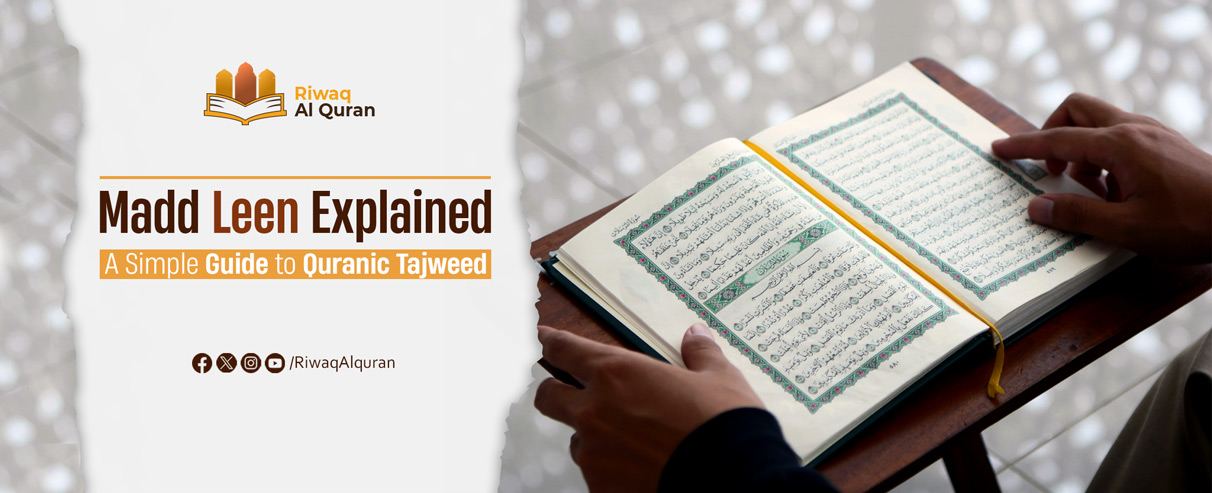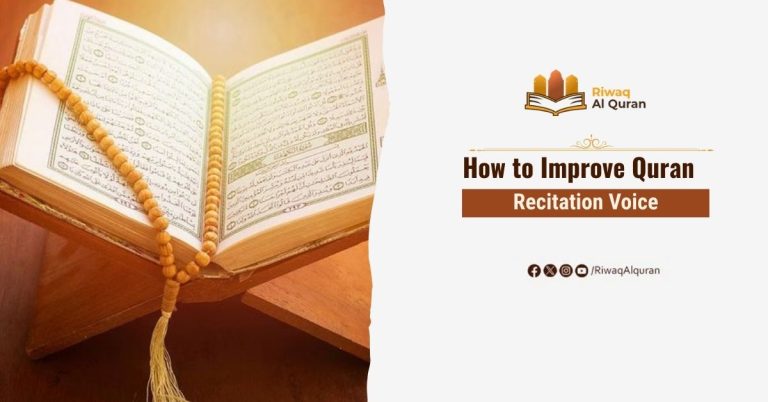Madd Leen (Arabic: مد لين) is an important concept in Arabic phonology. It has a special significance in the context of Tajweed, which is the set of rules governing the correct pronunciation and recitation of the Quran. Madd Leen is used to elongate sounds in a smooth and flowing manner, enhancing both the pronunciation and the rhythm of the language, particularly in the Quran.
In this article, we will examine the meaning and rules of Madd Leen, as well as its conditions. After that, we will explore how many Harakat Madd Leen has, along with Madd Leen examples in the Quran. Then, we will tackle the main types of Madd Leen: Madd Leen Aridh and Madd Leen Lazim. Finally, we will give some instructions and tips about how to perfect this topic.
Table of Contents
What is Madd Leen?
You may already know that the Arabic Madd letters are three: Alif (ا), Waw (و), and Yaa (ي). Madd Leen is to extend the Madd letter sound for 2, 4, or 6 Harakat [one Haraka is equal to one finger count]. For these letters to be Madd Leen, they must have 3 conditions [Madd Leen’s conditions]:
1- Madd letter must be Sakin.
2- The letter preceding the Madd letter has Fatha (َ) only.
3- The letter after the Madd letter has Sukon [this Sukon is either original or occasional (Aridh)].
To see what a Madd Leen letter looks like, please see the image below for the Leen Madd letters Waw (و) and Yaa (ي) with Tashkeel (تشكيل):

How Many Harakat Has Madd Leen?
Madd Leen can have 2, 4, or 6 Harakat. Most Quran scholars opt for 2 or 4 Harakat for Madd Leen. However, all of these three options are valid, provided that they are consistently implemented in your recitation. In other words, if you choose to make Madd Leen for 4 Harakat, you have to be consistent with all Madd Leen length throughout your recitation session.
Madd Leen Letters Examples
Now let’s move to a very good example of Madd Leen in the Quran. In the image below, we can see four valid examples of Madd Leen [the second red letters are the Madd Leen letters] in Quraysh Chapter.

These four words: “قُرَيْشٍ”, “ٱلصَّيْفِ”, “ٱلْبَيْتِ” and “خَوْفٍۭ” have the Madd letters: Yaa (يـ) and Waw (و) which are Sakin and are preceded with a letter that has Fatha (َ) [the first red letters]. The reciter should stop after each of these words as they are the final words of the verses, so the letters that come after the Madd letters become Sakin. The Madd Leen letters in these four words can have 2, 4, or 6 Harakat.
Madd Leen Types
There are two main types of Madd Leen. These are Madd Leen Aridh (Arabic: مد لين عارض) and Madd Leen Lazim (Arabic: مد لين لازم). Please see below what they are, how they are different, and some examples for each of them.


Madd Leen Aridh
To be Aridh (occasional), the Madd Leen letter must be followed by a letter that has an occasional Sukon [a temporary Sukon that occurs in specific cases when reciting the Quran, especially during pauses or at the end of a verse, where a normally Mutahrik letter will momentarily appear with no Haraka].
Madd Leen Aridh’s Examples
Examples of Madd Leen Aridh are hard to count in the Quran. Below are just two of these examples, followed by more detailed explanations.
“إِيَّاكَ نَعْبُدُ وَإِيَّاكَ نَسْتَعِينُ“
Since the reciter stops at the word “نَسْتَعِينُ” as it is the end of the verse, the final letter (ن) becomes temporarily Sakin, although normally it would have a Haraka [which is Dammah]. So the reciter can give the Madd Leen of Yaa (يـ) here 2, 4, or 6 Harakat.
“فَٱتَّبَعُوٓا۟ أَمْرَ فِرْعَوْنَ ۖ وَمَآ أَمْرُ فِرْعَوْنَ بِرَشِيدٍۢ”
Here, if the reciter chooses to pause after the first “فِرْعَوْنَ”, the Waw (و) in this word becomes Madd Leen Aridh, as the final “ن” letter in the word becomes temporarily Sakin while it originally has the Fatha Haraka. In this case, the reciter can give the Madd Leen of Waw (و) here 2, 4, or 6 Harakat.
Madd Leen Lazim
To be Lazim (mandatory), The Madd Leen letter must be followed by a letter that has a mandatory Sukon. That’s to say, the last letter that follows the Madd letter must be Sakin in all cases: whether the reader stops at it or connects it with the following word. Scholars have opted for 6 Harakat for this specific type of Madd Leen.
Madd Leen Lazim Types And Examples
Madd Leen Lazim has two main types: Madd Leen Lazim which occurs in one word and Madd Leen Lazim which occurs in a letter of Huroof Muqatta’a (الحروف المقطعة) of the Quran. Please see below a more detailed exploration of these two types:
1- Madd Leen Lazim In One Word:
This type of Madd Leen Lazim occurs in the same word. It is given 6 Harakat. Examples from the Quran include:
“فَإِذَا جَآءَتِ ٱلطَّآمَّةُ ٱلْكُبْرَىٰ”
“غَيْرِ ٱلْمَغْضُوبِ عَلَيْهِمْ وَلَا ٱلضَّآلِّينَ”
“فَإِذَا جَآءَتِ ٱلصَّآخَّةُ”
In these three examples, the Madd in the three bold underlined words is Madd Leen Lazim which occurs in a single word. In these specific words, the letter after the Alif (ا) is Mushaddad [stressed], i.e. consists of two similar letters: Meem (م), Lam (ل) and Kha (خ) respectively, the first of these stressed letters is Sakin and the second is Mutahrik. So the Madd Leen letter here is followed by a Sakin letter (that has a mandatory Sukon), so it has Madd Leen Lazim for 6 Harakat.
2- Madd Leen Lazim In A Letter Of Huroof Muqatta’a:
The most manifest examples of Madd Leen Lazim in the Quran are Huroof Muqatta’a (الحروف المقطعة) which come at the beginning of 29 chapters of the Quran. The Leen letters in these specific individual letters are examples of Madd Leen Lazim. Please see below:
“الٓمٓ”
In this verse, both Lam (ل) and Meem (م) letters are Huroof Muqatta’a and thus have Madd Leen Lazim in the middle letter: Alif and Yaa respectively. Please note that Lam (ل) and Meem (م) are pronounced in Arabic as ل – ا – م and م – ي – م. As these are letters which must be Sakin (مبنية على السكون), both Leen letter in the middle are Madd Leen Lazim and are given 6 Harakat.
Read more about: Types of Madd in Tajweed with Easy Examples And Charts
How To Learn Madd Leen?
To learn Madd Leen, you need to study Madd as a general topic in Tajweed. Then, you can learn about Madd Leen as a sub-topic of Madd. It is advisable to do some or all of the following steps to help you learn Madd Leen:
1- Understand the concept of Madd Leen and when it should be applied [definition and rules of the term].
2- Recognize the types of Madd Leen (Madd Leen Aridh and Madd Leen Lazim) with examples.
3- Learn the Rules of Madd Leen in Tajweed. You can enroll in one of the online Tajweed classes at Riwaq Al Quran to learn the basics of Tajweed.
4- Practice with examples (for example, you can stop [make Waqf] at the end of verses and learn to pronounce the letters with Madd Leen correctly, applying it with 2, 4 and 6 Harakat).
5- Listen to qualified reciters [you can listen to Shaikh Al Hossary and Shaikh Al Minshawy]. Pay special attention to how they apply Madd Leen in different contexts. For added benefit, you can look at the verses from the Quran when listening to the recitation.
7- Record yourself practicing what you have learned, to spot and correct your weaknesses. You can also try to watch yourself in a mirror while practicing this kind of Madd.
8- Receive feedback from qualified teachers/mentors. You can join Riwaq Al Quran to receive guidance from highly versed Quran teachers.


Learn Quran, Arabic And Islamic Studies Online With The Best Native Tutors
Riwaq Al Quran is a comprehensive online platform that offers personalized Quran, Arabic and Islamic Studies Online classes for individuals of all ages and backgrounds.
Their experienced instructors use a structured curriculum to cover Tajweed, Tafsir, and Memorization, providing easy and effective access to learning the Quran.
The advanced online classes allow for seamless communication and interaction between students and teachers. Join Riwaq Al Quran for a deeper connection with the Quran.
We offer several courses such as:
- Online courses for kids.
- Online Quran classes for kids and adults.
- Online Arabic courses
- Online Ijazah courses
- Online Islamic Studies courses.
Here are a sample of our set of Quran Courses that will be helpful for you:
- Online Tafseer Course: Delve into Quranic meanings with our insightful online Tafseer course.
- Noorani Qaida Online: Learn Quranic basics efficiently through our Noorani Qaida online program.
- Online Quran Recitation Course: Enhance Quranic recitation skills through our expert-led online course.
- Online Tajweed Classes: Master Tajweed rules for beautiful Quranic recitation in online classes.
- Quran Memorization Online Course: Memorize the Quran effectively with our specialized online memorization course.
- Online Qirat Course: Explore diverse Qirat styles with our comprehensive online Qirat course.
- Online Quran Classes for Kids: Nurture a love for the Quran in kids through interactive online classes.
Conclusion
Madd Leen is a crucial concept in Tajweed. Also, It is a sub-category of Madd. Studying it is essential for perfecting the Tarteel (ترتيل) of the Quran. It is crucial for preserving the beauty and clarity of the Quran according to Tajweed rules. It is not possible to learn how to recite the Quran accurately without learning Madd Leen. So by mastering the rules of Madd Leen, reciters can, not only preserve the Quranic message, but also be more connected to the Quran, the final word of Allah to mankind.


































